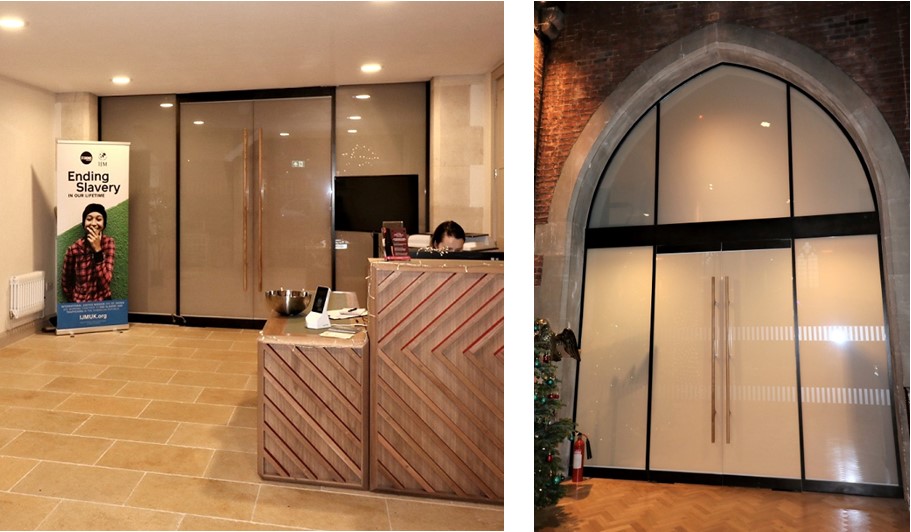Structural Glass Screens
Peter Hazeldean
| The new entrance to the church: the new glazing was considered to provide a more inviting entrance than the original solid doors (All photos: Ion Glass) |
Many places of worship in the UK are at risk of redundancy, and it is increasingly recognised that we must extend their use where possible. Bringing in others to share in the upkeep of these buildings is vital, particularly where the architecture is historic and the fabric is aging.
However, historic places of worship can be particularly difficult to adapt sensitively without losing much of their character and significance.
Subdividing them to accommodate separate uses may be possible in larger churches where there is an undercroft or other separate space, but architects often have to rely on the use of screen partitions to divide larger volumes.
One way to soften their impact is to use structural glass screens, carefully cut around the existing architectural features so that the alteration is reversible, minimising permanent change.
These have the advantage over more traditional details that the original form and volume of the interior space can still be understood and appreciated though the glass.
As distinctly modern features they also help to define new work without confusing the history and significance of the building as a whole.
The adaptation and re-ordering of St Dionis, on Parsons Green in London provides an interesting example of what can be achieved. This is a Grade II listed red brick church dating back to 1886.
Designed by architect Ewan Christian, it is in typical perpendicular Gothic style, incorporating a fine carved font and pulpit which originated from Wren’s St Dionis Backchurch in the City of London which gave the church its name.
Despite enjoying a prominent position directly overlooking the green, the original church façade was considered off-putting by the vicar, Tim Stilwell.
The entrance was small and dark, opening directly into an area used for church admin, so visitors were immediately confronted with desks and computers.
Key to welcoming in more people was a brand new entrance, replacing the wooden door with glass and opening up the brickwork on either side to create full height side panels.
The glazing to the new meeting room in the narthex with the privacy glass switched to transparent and (below) to obscure.
Tim had a vision for a centre in Parsons Green that would welcome all members of the local community and residents into the church.
His aim was to create a more accessible space with improved facilities, a kitchen and meeting spaces where people could meet, learn, teach, develop new skills and worship.
Working with architects Carden and Godfrey, designs were developed to fully reorder the church, commissioning heritage glass specialists Ion Glass to manage the extensive structural glass element of the project.
This provided more light and most importantly, visual access to the interior. The new entrance now opens directly into a welcoming reception area with the admin centre relocated to a mezzanine floor above, utilising the height of the building to create a modern office with space for desks, computers and people.

The new reception area (left) and its structural glass screen seen from the nave (right), with a new mezzanine level above the door: the use of switchable privacy glass allows the nave to maintain control over its privacy during funerals and other sensitive events.
From the reception a high stone archway leads into the nave. Originally in-filled with brick, the archway was opened up, replacing the solid wall with a full height glass screen and bespoke glass doors, providing a light, airy and welcoming vista into the church.
However, the introduction of glazing did raise some issues regarding privacy and safe-guarding, especially as the new office space above was built across the width the arch and clearly visible from the nave.
The church is regularly used by school groups who require privacy, and services such as weddings and funerals are better conducted away from the public gaze, without the distraction of the team working in the office.
The decision was therefore taken to specify switchable (privacy) glass so the whole screen can become fully opaque at the touch of a button.
| Structural glass cut carefully around a column to avoid making permanent alterations to an important original feature. |
A new meeting space was created to the rear of the church by completely enclosing the arches to the narthex with glass in-fill panels, installing double glass doors in the central arch.
Again, switchable glass was specified, making the area completely private when the glass is opaque and fully open to the nave when it’s transparent.
The reordering of St Dionis is very much a functional transformation as well as a visual improvement: the church has installed a kitchen with full catering facilities, able to provide meals for homeless guests as well as managing other functions and catered meetings.
Staffed by volunteers, meals for up to 70 people are cooked regularly for visitors to the Glass Door night shelter in the Mission Hall next door.
St Dionis is celebrating the reordering as a significant success: it has a vibrant and thriving congregation with a regular programme of events ranging from ‘Bacon and Bible’ breakfast sessions for men, curry nights for women and ‘Messy Church’ sessions for the kids.
The use of structural glass as a key element to upgrade and reorder a building such as St Dionis is an effective way to meet a variety of improvements and changes with minimal impact on the original architecture.
It introduces light, improves the visual welcome and can be employed to meet many different requirements – including an easy switch between full privacy and clear visual access.



